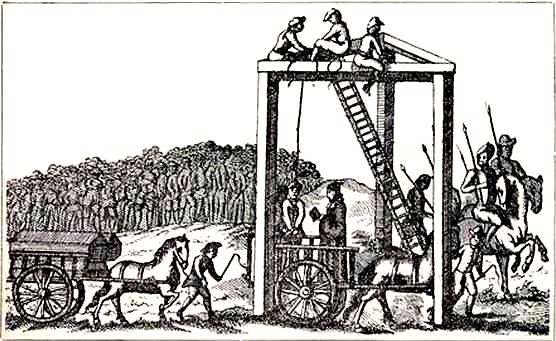|
Final Moments
 November 3, 1783 - John Austin, a highwayman convicted for "robbery with violence," became the last person to be hanged to death at the Tyburn gallows in present-day London. Tyburn was used for centuries as the primary location of the execution of London criminals. The first recorded execution at Tyburn occurred in 1196 when William Fitz Osbert was hanged for leading a populist uprising. In 1571 the "Tyburn Tree" was erected to be used for the executions. The Tree consisted of a horizontal wooden triangle supported by three legs. This allowed for multiple felons to be hanged at the same time. The executions at Tyburn were public spectacles and attracted crowds of thousands. So popular were the hangings that the villagers of Tyburn erected large spectator stands and began charging a fee to those wishing to watch. The executions also earned the village infamy as it became invoked in euphemisms for capital punishment -- to "take a ride to Tyburn" was to go to one's hanging, while "dancing the Tyburn jig" was the act of being hanged. After Austin's execution the gallows were disassembled and the executions were moved elsewhere. The site of the Tyburn Tree is marked today by stones placed in the traffic island at the junction of Edgware Road and Oxford Street, seen here. November 3, 1783 - John Austin, a highwayman convicted for "robbery with violence," became the last person to be hanged to death at the Tyburn gallows in present-day London. Tyburn was used for centuries as the primary location of the execution of London criminals. The first recorded execution at Tyburn occurred in 1196 when William Fitz Osbert was hanged for leading a populist uprising. In 1571 the "Tyburn Tree" was erected to be used for the executions. The Tree consisted of a horizontal wooden triangle supported by three legs. This allowed for multiple felons to be hanged at the same time. The executions at Tyburn were public spectacles and attracted crowds of thousands. So popular were the hangings that the villagers of Tyburn erected large spectator stands and began charging a fee to those wishing to watch. The executions also earned the village infamy as it became invoked in euphemisms for capital punishment -- to "take a ride to Tyburn" was to go to one's hanging, while "dancing the Tyburn jig" was the act of being hanged. After Austin's execution the gallows were disassembled and the executions were moved elsewhere. The site of the Tyburn Tree is marked today by stones placed in the traffic island at the junction of Edgware Road and Oxford Street, seen here. |
|
A Bump in the Sea
November 6, 1971 - An underground nuclear bomb, codenamed Cannikin, was detonated on the island of Amchitka in Alaska's Aleutian Island chain. The yield of five megatons was the largest underground nuclear test in U.S. history, with an explosive force 400 times the power of the Hiroshima bomb. The explosion caused a seismic shock of 7.0 on the Richter scale, and lifted the ground above the test site 20 feet. The force of the explosion also created a new lake, over a mile wide, at the test site. Though earthquakes and tsunamis predicted by environmentalists did not occur, there were a number of small tectonic events in the following weeks that were thought to be after effects of the explosion. A subsequent wildlife survey conducted by the University of Alaska also determined that between 700-2,000 sea otters were killed by overpressures in the Bering Sea caused by the explosion.
|
|
No One Said He Couldn't
 November 7, 1944 - Franklin D. Roosevelt, the popular Democratic president who took office during the Great Depression and led the nation throughout most of World War II, was elected for a record fourth term as President of the United States. Prior to Roosevelt seeking a third term in 1940, no U.S. president had served more than two terms based on a precedent set by George Washington. A presidential term limit was not enacted until the 22nd Amendment passed Congress in 1947 and was ratified in 1951. Incidentally FDR would serve less than three months of his fourth term before suffering a fatal stroke on April 12, 1945. November 7, 1944 - Franklin D. Roosevelt, the popular Democratic president who took office during the Great Depression and led the nation throughout most of World War II, was elected for a record fourth term as President of the United States. Prior to Roosevelt seeking a third term in 1940, no U.S. president had served more than two terms based on a precedent set by George Washington. A presidential term limit was not enacted until the 22nd Amendment passed Congress in 1947 and was ratified in 1951. Incidentally FDR would serve less than three months of his fourth term before suffering a fatal stroke on April 12, 1945.
|